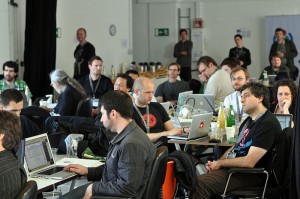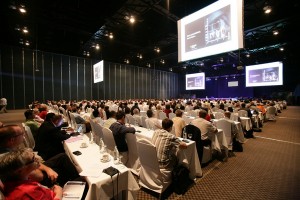
A few weeks ago, I asked, could we make conferences less sucky?
In that post, I pointed out the contrast between two meetings I’d recently attended and tried to extract some lessons for how to make conferences better. After some more thought and a lot of feedback from LWON readers, I have put together some rules of thumb on how to make a good conference.
Rule #1: Determine your objective.
It probably goes without saying, but each conference will have a unique objective, and everything about the conference, from the format to the location and the guest list, should serve this purpose.
Rule #2: Match the format to the purpose.
If the conference’s objective is to solve a big problem in the field, set up working groups that can collaborate in real time to solve them. If the purpose is to afford potential collaborators a chance to meet, give them an opportunity to interact. If it’s to disseminate the latest research in a particular field, give attendees a chance to discuss, digest and debate this new information in interactive groups.
Scientific conferences are often centered around the old “one scientist stands at the podium and lectures” setup, but there are plenty of other formats to choose from, including the fish bowl, the lightning talk, the knowledge cafe, and my personal favorite, the unconference.
Rule #3: Solicit input.
Don’t assume you know what attendees want, ask them. And then offer them a chance to participate. The ScienceOnline conference crowd-sources their sessions. “The organizers set up a wiki and attendees pitch ideas of what they want to see or present, so the ideas are honed throughout the year. They also keep up a year-round hashtag (#scio12) so attendees talk to each other and post relevant content across the seasons,” says attendee DeLene Beeland, who praises the conference’s content.
Asking attendees to contribute also engages them and ensures that they become active, rather than passive, participants. Crowd-sourcing a meeting’s content has the added benefit of providing a way for people to start building a sense of community before the event.
Rule #4 : Eschew the lecture.
Several LWON readers wrote to me and said that they abhorred lecture formats. “It’s like being stuck in college,” wrote one. A conference is an opportunity for face-to-face contact with your colleagues. Attendees want speakers to engage, not lecture to them.
In May of 2009, Frog Design analyzed the Lift Conference in Geneva to figure out what worked and what didn’t. One major lesson: “lectures were not well received.”
That doesn’t mean dropping talks entirely. Even a session featuring a one-way conversation between a speaker and the audience can be conversational and engaging. For evidence, check out any TED lecture, like this one from LWON’s own Jessa Gamble.
Rule # 5: Foster interaction.
People don’t go to conferences to hear someone read a paper that they could just as easily download online. They go to conferences to meet people. Conferences should aim to foster this interaction.
The Lift conference had attendees make “People previews” when they checked in. These were short videos of attendees explaining who they are and what they plan to do at the conference. The videos were shown live in real time so that other attendees could see who else was there. Such videos could also be made available to attendees during the conference to help them identify and connect with others who shared their interests.
Don Tapscott says that conference organizers should understand that their task is to build communities and provide a context for “things” to happen. The Aspen Environment Forum I wrote about previously does a good job of this. Food is served in a central location where people mingle and have plenty of room to stand around and talk. Patio tables provide quiet spaces for people to meet. Many of the lecture rooms feature tables arranged in a giant circle so that everyone is facing each other.
People often form conference buddy relationships naturally, but I’ve also attended conferences that successfully connected experienced scientists or journalists with newbies in a mentoring relationship. At another workshop I attended, everyone sat around a circle the first night and introduced themselves around the group until they’d learned everyone’s name. This may be taking it too far, but one blogger suggests speed-dating for conference attendees.
At the Society of Environmental Journalists meeting I attended last fall in Missoula, attendees could sign up for dinner groups, organized by subject matter. These group dinners provided a great opportunity to connect with other people with shared interests.
Rule #6 : Let there be light (and motion).
It’s a small, but important detail. Lock people up in dark, chambers and their natural inclination is to sleep. Instead, hold the conference in a space that features natural light and then give attendees a chance and an occasion to move around a little bit in between sit-down sessions.
At the Aspen Environment Forum, sessions are held in buildings scattered around a scenic campus, and walking to and from different sessions gives people a natural opportunity to walk and talk. I once attended a meeting where the lunch lecturer instructed the audience to get up and stretch.
Rule #7: Give attendees a task.
Ann provided a shining example of how conference attendees can bond and unite around a group task. As she wrote,
Get a bunch of smart, highly educated, intensely interested people together; ask them a question whose answer will open the glories of the universe; stick them in a room for the better part of a week; give them insufficient funds at the best of times and then when times are bad, cut the insufficiency; then 1) they get creative; and 2) they get organized, aligned, and aimed.
Not every conference will have the kind of urgent goal that Ann’s conference did, but the approach works. When forced to work together for a shared purpose, people bond and connect. It’s why members of sports teams and Air Force squadrons and research projects so often form close relationships.
If there isn’t a natural shared goal to work toward, find a task that is meaningful enough to engage people. It doesn’t have to be one of those silly ropes courses. It could be identifying an interest group’s most urgent unanswered questions and suggesting experiments to answer them or asking people to apply their expertise to an unsolved problem. Of course, it could also be a game of tug-o-war or a group hike.

Rule #8: Kill the nap-inducing PowerPoints.
After my first post on this subject, several people contacted me to say that they liked PowerPoint. Fair enough. They’re absolutely right that when done well, a PowerPoint can be a powerful tool for conveying information.
The problem is that most PowerPoint presentations are awful. They contain too many slides, the font is illegible from the back of the room, the default colors are impossible to read and the graphs cannot be deciphered on the screen.
PowerPoint slides should be like illustrations or photos that accompany a magazine article—they should add visual interest to the discussion, not regurgitate the information already being said. A PowerPoint should not be a telepromter for the presenter.
I like Guy Kawasaki’s 10-20-30 rule for presentations. He says you should have no more than 10 slides in your PowerPoint, which you should be able to get through in no more than 20 minutes. According to his rule, the smallest font that’s legible on the screen is 30 point.
Rule #9: Seek ways to reduce the impact of conference travel.
This final rule addresses a looming ethical concern. It’s a question that’s become important in the age of global climate change— is this trip really necessary? A conference that requires travel will inevitably produce a large carbon footprint, especially if attendees get to the meeting via airplane.
With good cause, climate change denialists have attacked the Aspen Environment Forum for its alarming carbon footprint. Simply by showing up, the experts attending the AEF make a hefty contribution to the very problem they had come to discuss. A round trip flight from Washington Dulles to Aspen, via Denver produces 1440 kg of CO2. The average citizen of India emits 900 kg of CO2 in an entire year. The Aspen Forum buys offsets, but that’s not a sustainable solution.
The WWF has a program in the UK to encourage businesses to reduce their business travel, and scientific organizations could follow their lead by working on ways to to reduce the carbon footprint of their meetings.
It’s not an easy task, but it’s possible. Some potential approaches include holding the conference every other year instead of annually, gathering people together in regional groups and then using videoconferencing to unite these regional groups with national ones, and using the internet and video technology to foster communication between far-flung participants.
This last point is an enormous issue, one probably worthy of a separate post.
My astronomy club has two presentations a month. About 20 of us give a single presentation a year. They’re about an hour.
My take on slides is the “no text” rule. I don’t read the slides because they don’t have any text on them. I will point out features, but where i used to use a laser pointer, i now use the laptop’s cursor.
I have notes, mostly an outline with any facts, but i try not to read from it. Eye contact with the audience is important.
The slide count isn’t as important. What slides do you need? One of my talks had 6 slides, and i flipped back and forth between them. The story i was trying to tell had complicated and counter intuitive logic and conclusions. The Holographic Principal. It’s what it took.
The talk can’t possibly cover every detail. So leave room for questions. I’m not sure why i’ve been able to answer them.
My policy is to take questions as they’re asked. I’ll even interrupt my own sentences to call on people. And, instead of answering them, i’ll often give the rest of the audience a chance. This has resulted in amazing discussions. You might think that not answering questions makes you look dumb. But what it really does is gives me (and the material) more credibility.
A rehearsal is a good thing.
GREAT ideas, Michelle. I’d like to add a couple:
#1Having been to many failing climate conferences of the United Nations as a reporter, I’d recommend thinking about good, inspiring food. In most conferences, food is crappy. At the UN Climate Talks, normal food is a sloppy, soggy sandwich wrapped in plastic. For 1 week! My private theory is that this is behind the utter failure of the CO2 talks. So good, light, natural, regional and diverse food is very important
#2 Give people a chance to move together, either with walks in the woods, or joint jogging, or morning yoga. It creates a sense of community, relaxes and frees the mind..
#3 Less titles, more questions. I’d love to attend conferences that ask a question and at the end, there is an answer or there are many answer. So instead of PUSH, by frontal lecturing, PULL by harvesting people’s mind and make them think about a question. That makes people PREPARE better instead of just shuffling their standard power point onto a stick.
Please keep this going, improving conference formats is probably one of the best ways to make a lot of things better. Billions are wasted with wrapping standard talks with fancy titles, without any tangible outcome…
These are excellent rules for having a better conference. Interaction is very important as mentioned in one of the rules. These rules can easily be turned into a best practices booklet